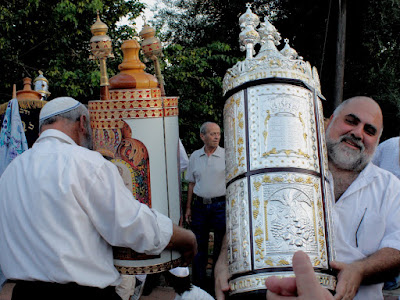Torah Scroll Initiation in Spharadi Synagogue
Yesterday in a small ceremony the neighborhood Sephardi synagogue initiated a new Tanach scroll (old testament) (see wikipedia Sefer Torah). This event happens only once in a few years. In a small neighborhood synagogue it may happen once every decade or so. Tanach scroll are read as part of the daily and Shabbat (Saturday) ritual prayer. Jews real the Torah in weekly portions covering the first five books in one year. The scroll itself is copied by hand by a trained scribe. This is a tradition of disseminating the books with complete accuracy going back two thousand years (or more). Torah scrolls cost a great deal (in the thousands to tens of thousands of dollars). They take months to years to write and apparently there are more prominent scribes than others. Overhearing one of the conversations apparently this Torah scroll was commissioned two years ago (or has been written in the last two years) and is a work of the third most capable scribe in this area. The silver box to the scroll is also a highly prized ritual item with dedicated craftsman showing their skills to the world. The box for this scroll is more ornate than the older scrolls currently used. Some scrolls do not have ornate boxes at all, they are simply covered with a cloth wrap (embroidered felt or silk).
The procession ended at the synagogue and evening prayer took place. Afterwords a big meal to celebrate the event was held. It is customary to hold a meal sponsored by a community member in every big event. Sometimes the congregation women cook and share, in this event a catered meal was served. The commissioning of a Torah scroll is a big event for a community. In Israel today it may seem trivial since the state sponsors synagogue costs and pays Rabbis. But this tradition of a community keeping a religious tradition and having the community resources to do it with style is crucial to the continuation of local synagogues. Like many neighborhoods in the central region of Israel, people here came from different countries. The Sephardi community is made up of families that chose to live in this neighborhood. The communities gathered around a synagogue in Israel do not carry the traditions of hundreds of years in the same village. Sephardis (Sepharadim - plural in Hebrew) came from different countries from as far east as India to the western north African countries with a small minority from Turkey and Greece. They adjusted to the new structure of the state while keeping as much as their communities together as possible. Three generations since they immigrated there are not many communities as a whole that can trace their ancestry to the same village or even region. But their religious practices are similar enough. An Iraqi Jew may have a slightly different melody to a song than a Moroccan but the prayer book and the ritual services are similar enough to feel comfortable.
Judaism is Israel's official religion. Americans feel a little strange, since the US does not have an official state religion. Britons and French do not have a problem at all here. As most countries, Israel is officially Jewish with most of the population secular. Small communities of more religious people gather around a rabbi or a synagogue. They make up less than 10% of the population. For the most part the state covers basic costs of buildings and related costs (prayer books, furniture, etc.) Rabbis serving a congregation receive a salary, which they usually supplement with other work. Like other state sponsored services, there is always someone that wants it better. This community certainly has done "better".
 An honor in the small community, carrying the Torah scroll for the first time to the synagogue / © 2009
An honor in the small community, carrying the Torah scroll for the first time to the synagogue / © 2009 Procession takes a rest, the group stretches the event for as long as it can giving the congregation regulars an opportunity to carry one of the scrolls / © 2009
Procession takes a rest, the group stretches the event for as long as it can giving the congregation regulars an opportunity to carry one of the scrolls / © 2009
Comments